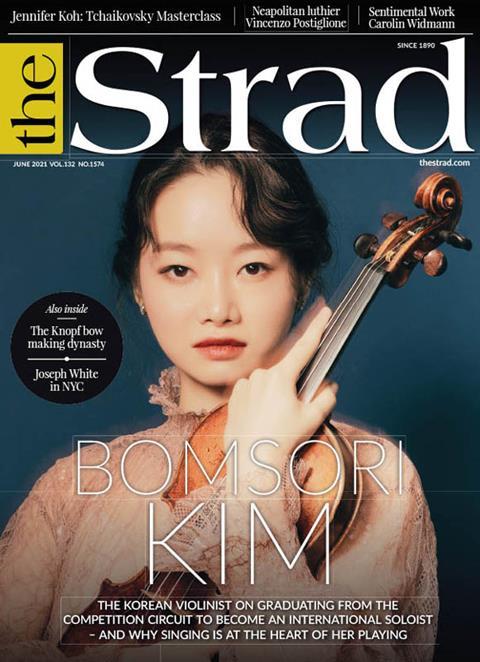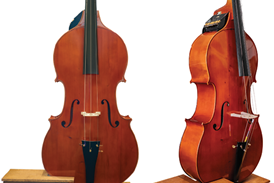Orchestras are among the musical ensembles to have suffered most during the pandemic. Pauline Harding finds out how some have been adapting their outlooks, products and processes in this new era of germ evasion and online streaming

Over the past year, to fit a symphony orchestra on stage and have a full audience in attendance has, for many, become an impossible dream. ‘You think about all of these challenges you might face in your life or career, and this was literally not even a hypothesis,’ says David Allen Moore, a professor at the USC Thornton School of Music and a double bassist in the Los Angeles Philharmonic (LA Phil). ‘It’s not even in the realm of something people fantasised about, such as “When the big earthquake comes in California, we might have to relocate until things are repaired.” No one thought, “What would happen if we were suddenly not able to do anything at all, in any sort of performance context, anywhere in the world?”’
Those orchestras that have managed to play, and those who plan to do so in the near future, have been forced to have a large-scale rethink. Coronavirus tests and thermometers are just the beginning. ‘The majority of the efforts are to do with prevention, and that starts even before you walk in the building,’ says David Alberman, principal second violin and chair of the board of directors at the London Symphony Orchestra (LSO). ‘We quickly learnt that we couldn’t have discussions with people about whether or not to wear masks, to be distanced, to use hand sanitation. These had to be conditions of working, and they apply to everyone.’ LSO players must also fill in a health questionnaire each time they enter LSO St Luke’s – the Hawksmoor church turned music education centre – and have weekly PCR Covid tests, provided in on-site pop-up tents by Imperial College London spin-off DnaNudge. The players are also encouraged to get vaccinated. ‘It’s been a mammoth undertaking,’ says Sue Mallet, the orchestra’s planning director. ‘We are watching the R rate to assess each week if we are doing the right thing. No one is saying these measures alone are the answer. It is a combination of what you can put in place.’
Once everyone is inside the rehearsal space, there are a number of ways to keep everything clean, from fumigation to UV surface sterilisation and simple elbow grease. At both the LA Phil and the LSO, on-site cleaners and sanitising mists have become a fixture after rehearsals and even in the breaks. ‘We have a cleaner constantly going around cleaning stair banisters and other surfaces,’ says Mallet. ‘We’ve also bought ourselves a fogger – a huge spray which disinfects and sanitises the chairs quickly after a rehearsal has finished. When we have socially distanced audiences, we fog the chairs after a performance and leave them for about ten minutes to dry.’ Foggers can be bought from a variety of manufacturers and should be chosen with guidance, based on the location, size and nature of a rehearsal space. Some should not be used with people or instruments in the room, so anyone using one is advised to lock doors or use a hazard light to warn others not to enter. ‘The LA Phil uses a fogger with a water-based disinfectant during the lunch break,’ says Moore, ‘so everybody packs up and puts everything away, just out of an abundance of caution. They don’t want to risk anything landing on a varnished surface and causing any issues.’
In addition to sanitising equipment, signs can help to remind everyone to wash their hands with soap regularly, for at least 20 seconds. Sanitiser gel dispensers should always be full and within easy reach. ‘Just don’t indulge in those practices you occasionally see of people resting their hand on the shoulder of an instrument, particularly if you’ve just covered your hand in alcohol,’ warns Alberman. ‘I wouldn’t obsess too much if your hand has to be in contact with the neck: man cannot live by thumb position alone, so just keep your hand away from the expensive varnished bits of the violin.’
Finally, each player should have their own chair and music stand, preferably with an inbuilt shelf to store a pencil and eraser, or to support a digital screen. Although some orchestras have been using software such as Scora and forScore to edit and share music electronically for a few years now, the pandemic has pushed many more musicians to take the next step. ‘All of a sudden, now that we have individual stands, nobody’s turning pages any more,’ says Meredith Snow, chairperson of the International Conference of Symphony and Opera Musicians and a violist in the LA Phil. ‘They’re using an iPad with a foot pedal, and for the first time in my life I’m thinking maybe it would be a good idea, so that I can download everything I need, without germs from anybody else touching it.’ It is advisable for players to use their own water bottles and coffee cups, too, and to avoid using public drinks dispensers. Attaching drinks holders to music stands can help prevent spills and remind everyone to stay hydrated. ‘The idea is that you do not touch anything that might have been touched by someone else,’ says Alberman. ‘If you have to move, you can’t just say, “I’ll use that stand over there.” Your stand and your chair have to be moved to your new location. If you’ve forgotten your pencil, you do not grab the pencil of your neighbour, nor do they grab yours. And if you need to look at their music, you try to stay two metres away and you squint.’
The two-metre rule causes its own complications. It’s easy to use signage to impose one-way systems and remind people to stay apart, and to have more frequent breaks to prevent toilet crowding. But for players in rehearsal and performance, having to sit so far apart makes it impossible to fit an orchestra into an ordinary rehearsal space. Even the 17,500-seater outdoor Hollywood Bowl cannot fit the whole 100-person socially distanced LA Phil on its stage. Instead, the orchestra has to be divided and spread out. These divisions are filmed individually on separate days, then edited together into episodic film concerts. The selected players change each time, and so both Moore and Snow have only played once each over the past year – Snow having previously played with the orchestra almost daily since 1986.
The distances also have a big impact on communication – especially for the particle-projecting brass and wind players, who have to stay even further away. At LSO St Luke’s they’re put in the balcony; in the Stuttgart Philharmonic, they’re kept three metres apart. ‘We did a recording of Rachmaninoff’s Second Piano Concerto and we had to remove every audience chair in the concert hall to fit the full orchestra,’ says Wassily Gerassimez, principal cellist of the Stuttgart Philharmonic, who is yet to play a ‘normal’ concert with it, having signed his contract only in March 2020. ‘The percussion section was sitting on the stage and the conductor was 100m away.’ When distances are so large, it can be hard for the conductor to be heard without shouting, so the LSO has started using a microphone during rehearsals, to minimise aerosol projection. Alberman now uses his phone, because ‘the distances are really quite difficult to manage sometimes, from the front of the section to the back. In the seconds, we take photos of bowings and send them back using WhatsApp, for the people who are a long way away.’
Plexiglass screens, used to stymie particle flow, make communication in these settings all the more demanding, distracting visually and distorting the sound. Although the LA Phil began by using large dividing screens throughout the orchestra, it later abandoned all but those used for the wind and brass players. In the LSO, now only the front-desk players use plexiglass shields, attached to their music stands to deflect rogue particles from the conductor. The Stuttgart Philharmonic has avoided screens altogether, although it has tried putting each player into a one-person inflatable plastic bubble, if only for an installation by conceptual artist Florian Mehnert. ‘We had to crawl in when they were deflated, and curl up like a baby,’ says Gerassimez. ‘It was really an uncomfortable situation, especially with a cello and a chair.’ Once the bubble was inflated, protected from his endpin by a champagne cork, he could not hear his orchestral colleagues and was nearly deafened by the sound of his own cello. Thankfully the players were released within half an hour, before suffocation set in.
Overall, face masks seem to be the simplest measure, and they have become the standard. Masks have now been invented that even cater for wind and brass players, and for another layer of protection D’Addario’s percussion branch has been making face shields out of drumhead material. In rehearsals, Moore uses a special mask to accommodate his beard, which ‘works really well because the bottom actually cinches along with the earpiece, so it creates a seal in a way that you can’t otherwise get with a bandana.’ For violinists, Alberman recommends anything with two-ply soft fabric. ‘If it is too thick and not soft enough, it will move as you put the instrument to your chin,’ he says. ‘If it moves up, you’ll be trying to look through the mask to see through your glasses, and then it’s game over.’ His particular favourites come from the Tate, the V&A and the British Library – or he suggests making one. In addition, he recommends ear-saving straps to avoid ‘that slightly off-putting feeling that your ears are being sawn off’. Some LSO members tie two masks together to form a cushioned support behind the head, or sew the elastic earpieces to a cloth strap. Other options include URSA Maskies – strain-relief straps which can be threaded through the earpieces and Velcro-fastened at the back of the head.
For glasses wearers, all manner of steam-preventing nose bridges and cages can be found online, although simply wearing the mask high up the nose and pushing the glasses over the top should allow breath to exit without causing lenses to steam up too much. Anti-fog sprays could also be worth a try. Snow and Alberman suggest that if all else fails, learning the music off by heart may be the best option.
Wearing a mask for hours can be unpleasant, so it’s important to take frequent breaks to get fresh air and improve concentration. Good ventilation is also key to prevent virus spread, through a combination of air-conditioning and open windows and doors. To allow players to get more fresh air without being rained on, the LSO has erected temporary marquees outside LSO St Luke’s, and both the LSO and the LA Phil are scheduling more breaks. Some orchestral musicians have abandoned the indoors altogether: Gerassimez has been arranging feel-good music for his five-cello Stuttgart Philharmonic section to perform in the gardens of local retirement homes, while in California members of the LA Phil have been hosting ‘concerts’ on their sunny home porches, just for the love of music.
Health protocols, of course, represent only part of the shift during the pandemic. At the moment, ensembles without in-house audio-visual technologies have fewer opportunities to perform. ‘Orchestras that had streaming capability already were actually in a better position when this started,’ says Moore. ‘The LA Phil pivoted and is doing a lot of really well-produced online things, but it’s not an orchestra right now: it’s a media company.’ The LSO had more of a head start, with recording facilities already in place in LSO St Luke’s, which it has now transformed into what Mallet describes as ‘a full-time all-singing, all-dancing venue for streaming’. She says: ‘We’ve kitted it out with cameras, camera tracks and all the paraphernalia needed to run a film company.’ The LSO’s Always Playing digital programme and the LA Phil’s Sound/Stage online concerts are in good company, with the Berlin Philharmonic’s Digital Concert Hall, the New York Philharmonic’s NYPhil+, and more. ‘It’s what we’ve expanded to do during the pandemic, in order to stay in touch with our audiences and stay relevant,’ says Snow. ‘I hope that live performances are always the major focus of what we do, but I also think that we’re always going to have drones up our butts now, filming stuff all the time. It’s the new reality.’
For those with lower budgets and fewer facilities, all is not lost. It may be some time before live audiences return to pre-pandemic levels, but Moore is confident that it will happen, and that in the long run online concerts will only make classical music more accessible to new audiences. Until then, even if it will never be possible to make any orchestra absolutely ‘Covid-proof’, with enough careful planning orchestras may be able to achieve something close. So far at the LSO, after all, ‘we’ve never actually had any players leave as a result of the disease,’ says Alberman. ‘We’ve been lucky – but like some famous golfers say, the harder you practise, the luckier you get.’
NO-TOUCH THERMOMETERS
iHealth No-Touch Forehead Thermometer £34.99
Kinetik Non-Contact Thermometer £14.99
LPOW Non-Contact Infrared Body Thermometer $29.99
Medisana TM 750 Infrared multifunctional thermometer £35.79 (right)
Tommeetippee No-Touch Forehead Thermometer £35.99
DOUBLE-LIPPED MUSIC STANDS AND CLIP-ON SHELVES
Bergerault Opera Music Stand €184
Gear4Music Music Stand Tray £2.99
Manhasset Orchestral Stand and Orchestral Concertino Stand $97.60; Clip-on Accessory Shelf $9.95
RAT Stands Performer3 Stand £40 (right); Alto Stand £55
Tiger Dual Lip Orchestral Music Stand £25.99
Wenger Bravo Music Stand with double lip £105
MUSIC STAND DRINKS HOLDERS
Gear4Music Microphone Stand Drinks Holder £4.99
Nordell Drinks Holder £9.97 (below)
Tiger Music Clamp-on Drink Holder £13.49; Cup Holder £10.99
DIGITAL SCORE SOFTWARE
forScore digital score app £19.99
Musicnotes sheet music app Free
Nkoda sheet music subscription service £99.99 per annum
Newzik collaborative web and iOS platform €34.99 per annum
Piascore Smart Music Score Free
Power Music App Free; £9.99 for extra features
FOGGER MACHINES
INMAKER Fogger Machine £189.99
SuperHandy Fogger Machine £199.99 (above)
PPE Products Direct Chemical Hand-Held Battery Fogging Machine £299
Storm Ballistic Virus Killer £658.80
PAGE-TURNING PEDALS
AirTurn Bluetooth Pedals $79–$129 (below)
Donner Wireless Page Turner Pedal $58.99
PageFlip Bluetooth Page Turner Pedals $89.95–$129.95
Wenger Stand Accessory Hands-Free Page Turner £220.70
PROTECTIVE SCREENS
Bergerault protection shields and protection screens for music stands €55–€180
RAT Stands Rshield BioScreens and Desk Screens £96–£294
Wenger Multi-Use Shield £259.20 (left)
TABLET STANDS
Hercules DG305B Tablet Holder £36.45 (right)
König & Meyer 19790 Tablet PC stand £29.72
RAT Stands Z3 Tablet Stand Pro £114
Scora StudyStand, PowerStand and Alto/Largo Stand €79–€149
Tiger Tablet Holder £20.49
Wenger Universal Tablet Stand £145.94
FACE MASKS
Assorted face masks and shields for musicians $9.95–$36
Diop face masks for beards $10
Museum-designed two-ply face masks from around £8
Available from museum shops including:
store.metmueum.org; shop.tate.org.uk;
Pulivia Mask Strap Extender £5.59
URSA Maskies ear-saving straps £5.95 (above)
ANTI-FOGGING SOLUTIONS FOR GLASSES WEARERS
3D Silicone Mask Bracket £8.99
Acitercy Anti-Fog Nose Bridge £8.99
ArtsyShopCo Breathable Anti-Fog Face Mask for Glasses £9.12
Muc-Off Premium Anti-Fog Treatment £9.99 (right)
-
This article was published in the June 2021 Bomsori issue
The Korean violinist on graduating from the competition circuit to become an international soloist - and why singing is at the heart of her playing. Explore all the articles in this issue . Explore all the articles in this issue
More from this issue…
- Korean violinist Bomsori
- The Knopf bow making dynasty
- Violinist Joseph White’s 1875 New York debut
- Sitkovetsky Trio on recording Ravel
- Master copyist Vincenzo Postiglione
- London-based string group the 12 Ensemble
Read more playing content here
-










































No comments yet